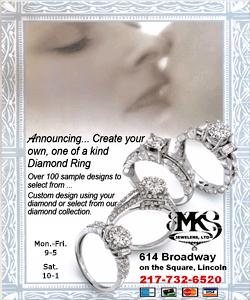|
What can you learn from an old
button? A lot
 Send a link to a friend
Send a link to a friend
[September 26, 2015]
LINCOLN
- When Cheryl Bakerís grandmother decided that she wanted to collect
something, she went all in. One of her many passions was collecting
buttons. When she passed on, her only relative who wanted the
collection was her granddaughter. Baker, from Emden, brought part of
her grandmotherís collection to the monthly meeting of the Logan
County Genealogical and Historical Society Monday evening.
|
|
 Cheryl Bakerís grandmother stored her button collection under her
bed. When Cheryl inherited it, she did likewise because the
collection just did not interest her. One day she got it out and
went through the collection and was hooked. Cheryl Bakerís grandmother stored her button collection under her
bed. When Cheryl inherited it, she did likewise because the
collection just did not interest her. One day she got it out and
went through the collection and was hooked.
Each button had a history and represented part of American history.
Baker was fascinated. Her grandmother had hand sewn each button onto
a tea towel, disregarding the color of the towel as it impacted the
colors of the buttons affixed to it or the type of button. Each
towel was a jumble of colors and button types. ďThe colors of the
towels and the buttons were terrible,Ē said Baker.
Baker went about joining the National Button Society and researched
the proper way to present the collection. She soon learned that
buttons are displayed by composition. This meant removing the hand
sewn buttons from the towels and gathering them onto display boards
with those of a like composition.

Baker remarked that buttons have been around since 4,000 B.C. Over
the centuries, they were made from all sorts of hard objects that
were at hand. Bone, antler, gold, and earthen ware were some of the
early materials used. Later they were made of pewter, brass,
scrimshaw, wood, and cork. Modern buttons, at least those from the
past century, were made of some manmade materials such as celluloid,
Bakelite, and Lucite. Now, buttons are mostly plastic.
ďCollecting buttons made from unusual materials ended many years ago
when plastic became the material of choice. Now there is nothing to
collect,Ē said Cheryl Baker.
While we take buttons sewn to our clothes with thread for granted,
button holes did not appear until the 13th century. The earlier ones
were looped onto the material. Once holes appeared, all buttons were
affixed to the left side of menís and womenís clothing.
It was not until the 16th century that menís buttons were moved to
the right side of shirts. The reason is another history lesson. Men
carried their swords on their left hip, so for quick access to a
weapon buttons were moved to the right so that they could be quickly
unfastened with the left hand leaving the right hand free for a
quick grab of the sword. Womenís buttons remained on the left.
Nothing has changed in the past five centuries.
The most prolific era of button construction was the mid-19th
century. Styles and materials abounded. Many were used as decoration
for fancy dresses and suits, while others were placed for practical
purposes.
Bathing wasnít a daily practice during the 19th and early 20th
century, so one can imagine the body odor issues. Cloth buttons were
developed so that a dab of perfume could be placed on them to cover
an unpleasant smell.
Spats were used to cover the bottom of pants legs and shoes to keep
them clean in the 19th century because most streets and sidewalks
were dirt. The spats were held in place with buttons and a button
hook was invented to easily stretch the buttons across the material
of the spat.
[to top of second column] |

When a man was dressed in tails for that very special fancy event, two buttons
were placed on the rear of the trousers so that the tails could be attached to
keep them from getting dirty while the man rode his horse to the ball. Those two
buttons are still a fixture on tail coats, although riding in the limo to a
fancy event is no longer problematic for cleanliness.
And the three buttons on the underside of the sleeve of a manís suit or sport
jacket? Those are purely decorative and have been around for centuries.
Cheryl Bakerís personal passions are brass and glass buttons. She passed around
samples of black glass buttons that were developed in England in the 19th
century.
One entire display was brass buttons that had come from uniforms. The person
wearing the clothing had to keep those buttons bright with lots of elbow grease.
Military uniforms, police, and the trolley conductor all wanted to look good.
Illinois had several button factories, Peoria and Pekin were two large ones.
Mother-of-Pearl was very popular as a button material at these factories. They
were made from mussels that were dredged by the millions from the Illinois
River. This practice decimated the mussel population in the river, an ecological
disaster. The practice was banned in 1974.
Cheryl Baker continues her passion for button collecting that was passed down
from her grandmother. ďIím a member of several central Illinois button clubs as
well as the National Button Society. The local clubs get together several times
a year to buy and sell and discuss buttons.

Itís difficult to find valuable buttons at every day swap meets and antique
stores. Those have mostly been found by serious collectors,Ē she said. Buttons
may seem like a mundane part of our everyday lives, but they can tell a
fascinating part of history.
The Logan County Genealogical and Historical Society meets the third Monday of
every month at 6:30 p.m. at their research facility on Chicago Street in
Lincoln. They always have an interesting guest speaker, and the meetings are
open to the public.
[Curt Fox] |